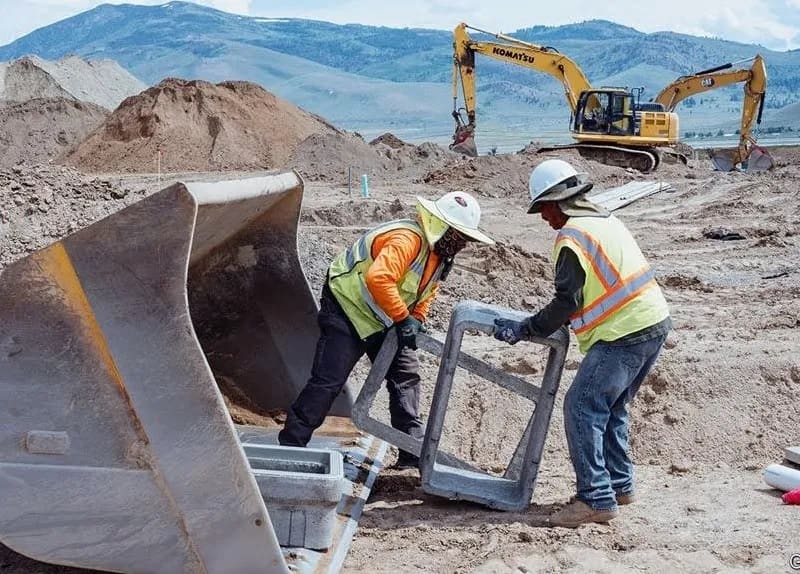
By Peter Bowe, Publisher, DredgeWire
Just over three months ago I co-authored a piece about how avoidable bureaucratic delays and policy choices by the Biden administration are slowing new infrastructure spending despite massive new funding commitments including the so-called Bipartisan Infrastructure law. (See https://dredgewire.com/
Now a recent article by the respected newspaper The Economist has highlighted the same issues including a good graph showing the extent of the decrease in American infrastructure spending. Further it calculates that not only has spending increased less than expected, but it has actually declined in real terms!
It’s worth revisiting the issues in the hopes that with increased visibility the administration will change course to achieve its stated aims on infrastructure.
The Economist started by noting:
“With headlines proclaiming its $1.2trn in investments, worth about 5% of gdp, it was easy to get caught up in the excitement. That makes the current state of the big dig all the more disappointing. Instead of the anticipated surge, total infrastructure spending has fallen by more than 10% in real terms since the passage of the law (see chart).

So, what’s the problem?
There are several.
First, as everyone knows, higher inflation has impacted all sectors of the economy, but it’s been even worse, far worse, in construction where costs have risen as much as 50%. DredgeWire has reported extensively about the massive negative impact this has had on US offshore wind projects, with, as just one example, the leading developer Orsted abandoning multiple East Coast projects despite forfeiting substantial performance guarantees.
The Economist elaborated: “A lot of the cost estimates that states and local agencies have are from three to five years ago, and they are just totally off now,” says Santiago Ferrer of BCG, a consultancy. This, he adds, leads to two outcomes: either authorities get no bidders because contractors think their prices are too low; or they revise their cost estimates, which takes yet more time.”
DredgeWire reported on one such example just this week (https://dredgewire.com/pipeline-dredging-in-the-hatteras-ferry-channel-unlikely-this-winter/) where North Carolina has delayed critical ferry channel dredging because “the Corps found that the pipeline project cost increases have left its budget about $3 million short.”
A chart from Ed Zarenski shows how inflation in the construction sector accelerated dramatically starting in 2020 according to multiple independent indices:

Regulation continues to be problematic
My prior piece in DredgeWire noted the deleterious impact of new regulations which have slowed bidding processes and added costs. Refer to https://dredgewire.com/dred
The Economist agrees:
“(The Biden administration has) also loaded on requirements to promote racial equity, environmental sustainability and fair wages. Laudable as these goals are, they have slowed things down. “The administration is at war against itself. It wants to advance these projects aggressively. But some of its requirements just preclude their delivery,” says D.J. Gribbin, a consultant and former general counsel in the Transportation Department. The law also included more than 100 new competitive grant programmes, which require new application systems and new compliance procedures. “These are a nightmare to set up and run,” Mr Gribbin says. Some state and local officials are not even bothering to apply for funding.”
Ouch! The practical realities of these new rules are now being felt across all government procurements certainly including marine construction and dredging. It’s probably unreasonable to expect the administration to make a lot of changes given its other social priorities, but as a society we should at a minimum recognize their impacts and reconsider how best to achieve a better balance of policy objectives.
Last but not least the omnipresent problem of permitting has not gone away, but has gotten worse. The Economist offers this insight:
“Another familiar obstacle is getting permits. The Biden administration has created a special action plan to try to speed up approvals for infrastructure and clean-energy projects. At the same time, though, its appointees in the Environmental Protection Agency have given states more power to block infrastructure projects because of fears about water quality. “The administration’s record on permitting is mixed at best,” says Ken Simonson of the Associated General Contractors of America.”
In fact doing a key word search on DredgeWire articles for “delay” over the past two years yields over 1,000 results!
Other than fixing inflation, what’s to be done?
In my earlier piece we noted how continuing remote work by the USCOE and its various district offices has exacerbated timely permitting for dredging and marine construction projects.
Government at all levels, not just Federal, but state and local as well, could quickly improve the infrastructure investment environment if staff involved in permitting, and bid issuance and awarding, returned to the office. This could largely be done by executive decision and would have the substantial side benefit of re-energizing the downtowns where these government offices and employees are located.
Secondly, while more difficult to achieve, the Biden administration should review its regulatory framework with a goal of reducing incremental burdens which it has imposed. This would first require a recognition of the problem.
Supply and Demand
Given the demand from all the new spending, if progress is not made resolving these issues we can expect continued inflation and disappointment in infrastructure project implementation.





























































